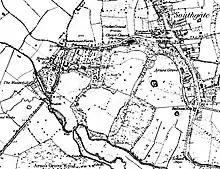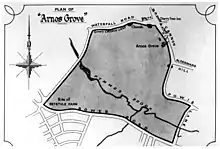Beaver Hall
Beaver Hall was a country house in Middlesex, England. It was set in grounds of around 40 acres (16 ha) that stood to the east and south of the current Waterfall Road, then known as Waterfall Lane and Church Hill, near the old centre of Southgate. The grounds stretched as far south as the Pymmes Brook where Arnos Park was later built.[5] Beaver Hall was acquired by John Walker of the Taylor-Walker brewing family in 1870. The house was demolished in 1871 and the grounds merged into the adjacent Arnos Grove estate.




The house
According to Nikolaus Pevsner's The Buildings of England, the house was built in the 1760s, possibly to a design by the architect Sir Robert Taylor[6] who also worked on Arnos Grove house. It stood near the corner of the modern Waterfall Road and Chandos Avenue.[5]
It was drawn and engraved by John Hassell in 1804 at which time it was the home of the merchant and shipowner John Locke.[1] Subsequently, it was the home of the Schneider family, who moved to England from Switzerland in the eighteenth century. Henry Schneider, industrialist and politician, was born there in 1817 to the merchant John Henry Powell Schneider (c. 1768 – 1861) and his second wife, Elizabeth Moule.[7]
The house was occupied by the railway contractor Joseph Thornton (1804–1889)[8] and his family from at least 1858.[9] The 1861 census shows him there with his wife Amelia and six children (one visiting with her husband), a governess, lady's maid, nurse, cook, butler, footman, and four other maids.[10]
Demolition
The house and its grounds were acquired by John Walker of the Taylor-Walker brewing family in 1870.[11] The house was demolished in May 1871[8] and the grounds merged into the adjacent Arnos Grove estate as part of what Alan Dumayne called a "private green belt" policy of the Walkers of acquiring neighbouring estates and demolishing the house in order to prevent local development.[12] The Walkers had done the same with the adjacent Minchington Hall in the 1850s.[12]
The stone from the house and many of the fittings were used in the construction of Stone Hall in Church Hill, Winchmore Hill, in 1872.[8]
References
- Beaver Hall, Southgate. published 1 Jun 1804. Royal Collection Trust. Retrieved 17 January 2019.
- Sheet 007 Map of Middlesex. Originally published by Ordnance Survey, Southampton, 1868–1883. British History Online. Retrieved 19 January 2019.
- Dumayne, Alan. (1987) Southgate: A Glimpse into the Past. London: Alan Dumayne. p. 131. ISBN 0951228609
- Newby, Herbert W. (1949) "Old" Southgate. London: T. Grove. p. 39.
- Dumayne, p. 145.
- Pevsner, Nikolaus & Bridget Cherry. (2002). The Buildings of England: London 4 North. New Haven & London: Yale University Press. p. 29. ISBN 0300096534.
- Schneider, Henry William (1817–1887), industrialist and politician. Oxford Index. Retrieved 18 January 2019.
- Pam, David. (1982) Southgate and Winchmore Hill: A Short History. London: Broomfield Museum. p. 13.
- Crosthwaite, John Clarke. (1858). The History of Esther an Illustration of Providence. Twelve Lectures, Delivered in the Church of St. Mary at Hill, London, in the Year 1852 &c. London: Rivingtons. p. xv.
- Joseph Thornton England and Wales Census, 1861. Family Search. Retrieved 19 January 2018. (subscription required)
- "Some Account of Southgate" by C. Edgar Thomas in The Home Counties Magazine, Vol. XI, 1909. pp. 167–181 (p. 176).
- Dumayne, pp. 125–126.
Further reading
- "Two Crystalline Villas of the 1760s" by Richard Garnier, The Georgian Group Journal, Volume VII (1997).
External links
 Media related to Beaver Hall at Wikimedia Commons
Media related to Beaver Hall at Wikimedia Commons